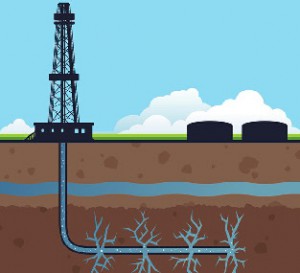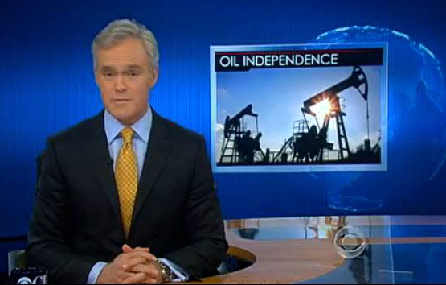Written in the spring of 2012, this paper is a “thought piece” and exposé on a controversial gas drilling process called “fracking”. This is a complex and still timely topic, especially with the related FRAC Act waiting to be debated in the House of Representatives. It may well be that this legislation, introduced in 2009 and again in 2011, will never reach the floor due to lobbying efforts and politics. [UPDATE: as of the date of this post, the status of this bill has not changed]

Introduction
Hydraulic fracturing or “fracking” is a well-drilling method used by oil companies to extract natural gas from shale. This method works by pumping, under extreme pressure, millions of gallons of fresh water ladened with not-fully-disclosed, but toxic chemicals deep into the earth to break up the shale so that gas and oil can be extracted. By its demonstrated effectiveness, together with its presumed environmental consequences, this method is reminiscent of the above-ground hydraulic mining methods or “hydraulicking” used in the 1850’s through the 1870’s during the California Gold Rush.
Hydraulicking left vast areas of farmland in the Sacramento Valley deeply buried in mining sediment. This devastation led to the most renowned legal fight of farmers against miners in the landmark case of Edward Woodruff v. North Bloomfield Mining and Gravel Company with the United States District Court in San Francisco deciding in favor of the farmers in 1884. This decision banned the hydraulicking practice in certain areas flowing into streams and rivers.
While promoting passage of the Fracturing Responsibility and Awareness of Chemicals Act, or FRAC Act, introduced by Senator Bob Casey on March 15 2011, U.S. Rep. Jared Polis of Colorado said in a press release [24], “There is a growing discrepancy between the natural gas industry’s claim that nothing ever goes wrong [with fracking operations] and the drumbeat of investigations and personal tragedies which demonstrate a very different reality.”
What is the reality demonstrated by hydraulic fracturing? Should the practice be banned or regulated as with the FRAC Act, which would place it under the framework of the Safe Drinking Water Act and would require energy companies to disclose the chemicals used in the fracking process? Does the public have a right to know what may be contaminating their drinking water or will such regulation collapse the natural gas industry in the United States, as some have claimed?
The promise of energy independence
Every day the United States consumes 20 million barrels or about 24% of 85 million barrels of crude oil produced worldwide, which is up 20% from the decade before [1]. Altogether, 70% of this daily domestic consumption is used just in transportation with 9 million barrels being transformed into gasoline. Nearly 60% of this daily domestic consumption is imported with 6 million barrels a day coming from OPEC nations, contributing to over 700 billion dollars flowing into OPEC nations in 2007 from all oil-hungry countries around the world.
From September 2007 through October 2008 an unprecedented one trillion dollars was transferred from European, Asian, and American economies into the Middle East national treasuries in exchange for oil. Although these transfers decreased to around $800 billion in 2010, questions continue to arise about the connection between this massive cash flow into the Middle East and a corresponding flow of terrorism out of the same region.
Since the 1973 Arab oil embargo, the United States has been unsuccessfully pursuing energy independence as a national priority. However, in 2011 America’s oil imports declined to 50% as a fraction of consumption. This welcomed decline was mostly due to three economic factors happening at the same time [2]: (1) the Great Recession effects on transportation activity since 2008; (2) rising oil prices leading to reduced demand for oil imports; and (3) significant growth trends in domestic oil and in natural gas production especially.
The primary reason for this expansion in domestic oil and gas production is the natural gas extraction technology for shale formations called “hydraulic fracturing”. Being developed by Texas wildcatter George Mitchell back in the 1980’s, this technology has not been unknown but has come more into favor now as the easy-to-extract oil becomes more difficult to find. The formations where domestic gas and oil reserves are now being recovered are much deeper and therefore have much more geologic pressure to overcome. This is where fracking comes into the discussion.
Since its renewed interest, the cost of fracking for natural gas has become so competitive that most of US natural gas production comes about through fracking. The inventories of natural gas in this country are becoming so bloated from the production efficiency of fracking that there is even a possibility for the price to be temporarily driven to zero.
Where the marginal private cost of producing an additional unit of natural gas equals the marginal revenue (price) is where economists define the optimum production quantity. If that price is near zero, this indicates extraordinary production efficiency and an over-supply that is driving down the price. This was not the case before fracking. Prior to the North American natural gas boom, U.S. energy companies built import terminals for liquefied natural gas (LNG) that was mostly a byproduct of foreign oil production using conventional drilling methods. LNG is the form most economical for transporting natural gas.
This collapse in the natural gas prices caused by this excess national supply of natural gas and no way to export it has recently led energy companies to build facilities like the Texas-based Cheniere Energy’s natural gas export plant planned at Sabine Pass. Natural gas can fetch five times the U.S. price in Asia or Europe [10]. As we shall discuss, notwithstanding producer preferences, the exportation of domestically-produced natural gas is controversial.
It is no wonder that everywhere there is a rush to substitute gas for oil. Even the automobile industry is looking to natural gas, compressed and LNG, as potential engine fuel [11]. For example, in 2012 the Ford Motor Company has eight alternative-energy vehicles powered by natural gas. Chrysler recently unveiled an LNG-powered truck that will go on sale in June.
Arguably, fracking has made the United States self-sufficient in natural gas and is leading to a significant reduction in our dependence on foreign oil as a consequence. Just over the past few years, the price ratio of a barrel of oil to a million BTUs (or a thousand cubic feet) of natural gas increased from 11 to 50. At the moment, it seems that the North American natural gas boom is having nothing but positive consequences for our country.
Economic prosperity or quality of life, which is it be?
The first “raindrop” of criticism of fracking came to West Texas on 30 June 2009 when the Texas Commission on Environmental Quality found hexavalent chromium (or chromium-6) contamination in about one-third of the 125 drinking water wells tested and serving more than 40 homes Cotton Flats, a community south of Interstate 20 on the fringe of Midland. The highest reading for chromium-6, a known human carcinogen, was 5,250 parts per billion – more than 50 times the maximum allowed by EPA. This event at Cotton Flats would eventually turn into a downpour of concern by the local citizens about the health impact and safety of fracking.
Schlumberger, an oil and gas industry hydraulic fracture giant, has a plant next to the affected Midland neighborhood where oil filed waste are dumped. Chromium-6 is the same substance found in Hinkley, California by the famous environmental activist Erin Brockovich from whom the residents of Cotton Flats enlisted help. Brockovich said about the Cotton Flats contamination, “The only difference between here and Hinkley is that I saw higher levels here than I saw in Hinkley [4].” Schlumberger said they never use chromium. However, chromium is regularly found in waste pits that hold fracking flowback.
At a community outreach meeting that I attended in mid-2009 along with representatives from the Permian Basin gas and oil producers, the subject of fracking came up, undoubtedly influenced by the recent events in Cotton Flats. At this time, the community was already well aware that the availability of water in the region was already being threatened by a record drought. Citizens of the Permian Basin were being warned that water-rationing days were just ahead. “What if now we find that the available water is no longer safe to drink?” “Is our local drinking water being threatened with contamination from this technology that is, at the same time, breathing new life into the area?” “Are we burning the furniture to heat the house?”
The response to this concern from the attending gas and oil folks was a bit surprising. It wasn’t to not worry about water contamination. Their concern was that if fracking were to be banned or regulated, the town could no longer exist. Without fracking, most of the oil wells in the Permian Basin, indeed the country, would no longer be economically viable to exploit unless, of course, the price of oil rose even further. To me, this seemed like a “your money or your life” choice.
Fracking requires water. Lots of it!
What was not appreciated by me and perhaps many of the other citizens at that meeting is that fracking requires huge amounts of fresh water that will assuredly become contaminated through the process. Yes, fresh water is preferred, as it lacks the impurities found in brackish water, which can compromise the fracture stimulation. The fracking process requires anywhere from 50,000 to 10 million gallons of water for each fracked well. It has been estimated in one West Texas county alone [12] that water use for fracking could soon make up more than 25% of the county’s annual water use, with that portion becoming silently and perhaps irreversibly contaminated and undrinkable.
This cross-purpose demand for the same scarce resource sets up a Sophie’s choice situation, especially at a local level, for the citizens of the West Texas Permian Basin between economic prosperity and quality of life. Further complicating the situation, the water level of the massive 34,000-square-mile Edwards-Trinity Plateau Aquifer positioned underneath the Permian Basin has declined steadily over the past decade and only recharges when the average annual rainfall is 15 inches or greater.
The water consumption impact of fracking is not isolated to West Texas. In 2010, the Environmental Protection Agency (EPA) estimated that the water used to fracture 35,000 wells in the United States each year is equivalent to the annual water consumption of 40 to 80 cities each with a population of 50,000. This extraction rate has raised concerns about the ecological impacts on other aquatic resources and the dewatering of drinking water aquifers.
The problem is not confined to the Permian Basin.
Energy industry analysts generally concur that hydraulic fracturing is essential for recovering what has estimated to be a 100-year supply natural gas from shale formation nationwide including the Marcellus in New York and Pennsylvania and the Eagle Ford in south Texas [5]. Indeed, an increasing proportion of the American landscape (e.g., 34 states in 2009) is becoming dotted with hundreds of thousands of new oil wells and drilling rigs, everywhere emulating the look and feel of the Permian Basin. The promises of fracking for huge gains in extraction efficiency has the country scrambling to tap this century’s latest “Gold Rush”, but this time for natural gas locked deep underground in myriad tiny bubbles between thin layers of shale rock.
Energy companies are even receiving rare support from environmentalist, their usual, perennial nemesis. These environmentalists see the increased use of natural gas helping to slow climate change because it burns more cleanly than coal and oil. Moreover, politicians of all stripes are hailing gas as a desperately-needed source of jobs. So what’s the problem?
The problem is that as we shift away from coal and toward natural gas, trying for cleaner air and energy independence, we seem to be at the same time producing massive amounts of toxic wastewater with salts and naturally occurring radioactive materials and there seems to be little consideration for any effective plans for handling this waste. Indeed, it is documented that wastewater from fracking processes, and lots of it, is sometimes hauled to sewage plants not designed to treat it and then is discharged into rivers that supply drinking water downstream.
For example, Pennsylvania, which has seen a sharp increase in drilling with a doubling of active gas wells since 2000, is the subject of a never-made-public 2009 study by the EPA, which concluded some sewage plants were incapable of removing certain drilling wastes contaminants and were probably violating the law. In other never-reported EPA studies, it was concluded that radioactivity in drilling wastes cannot be fully or safely diluted in rivers and other waterways.
More alarmingly, most sewage treatment plants that accept drilling wastewater to not have to test for radioactivity; nor have federal and state regulators required testing for radioactivity at downstream drinking-water intake plants since before the drilling boom began in 2008. What is guaranteeing that the drinking water taken from these plants is safe?
This unanswered question has experts worried, especially in Pennsylvania where the risks are particularly severe with the level of radioactivity in the wastewater being sometimes hundreds to thousands of times the maximum allowed by federal standards for drinking water. Although people do not drink drilling wastewater, the drinking water standard is used in the absence of any comprehensive federal standard for safe levels of radioactivity in drilling wastewater – the stuff that is sent to sewage treatment plants that may well be incapable of rendering it harmless.
Why the lack of regulations?
Why the lack of regulation on what seems to be an arguably environmentally-risky oil and gas extraction process? A monumental reason is the so-called “Halliburton loophole”. At the urging of then vice President Dick Cheney, former CEO of Halliburton, a gas drilling company, Congress exempted fracking operations from being regulated under the Safe Drinking Water Act in 2005 [6].
Tucking specific language into the Energy Policy Act, energy production companies were also relieved from having to disclose the chemicals that they are using in fracking operations. If you don’t know what is being used in the drilling process or in the wastewater, you cannot test for its persistence in the environment or relate it back to a particular fracking operation. Later in 2011, Congress released a report [7] that revealed these chemicals include toxic agents, twenty-nine that are known as possible human carcinogens.
Information about the “chemical cocktails” used in fracking processes is further limited because the energy industry claims formulas are trade secrets and thus proprietary information and protected by law. Nonetheless, what is known, as could be obtained under the Freedom of Information Act requests from states, is that “92% of the 278 known chemicals used to produce natural gas have adverse health effects including endocrine disruption, neurological disorders, and cancer [8]”
It would seem that effective disclosure laws would require the names and concentrations of individual chemicals pumped into each well. The federal Bureau of Land Management has drafted such a regulation [9] but only for wells drilled on federal land. In order to study the health effects of natural gas development and to deal with emergency spills, health care professionals and scientists say they need this information to track water and air quality near drilling sites [9]. However, Colorado is the only state that currently requires this information.
What is fracking, end to end?
Why does fracking require so much water? If the process requires fresh water to stimulate fracturing, why is there the need for the added ingredients? Where does all of this water go after the wellbore is completed? How are nearby drinking water sources protected from any contamination produced through the fracturing process? A short, end-to-end description of the hydraulic fracturing process will help to address these questions.
Geologic formations deep below the earth’s surface (e.g., 5,000 to 20,000 feet), such as tight sands, shales, and coal-bed methane formations where large amounts of gas and oil are found often have a poor, uneconomical flow rate due to low porosity, permeability, or reservoir pressure. These formations are naturally fractured hydraulically, but industrial fracturing (i.e., fracking) widens these natural fractures or even creates new fractures to increase the flow of gas and oil from source rocks to reservoir rocks, such as porous sandstones, limestones or dolomite rocks near the wellbore. The fractures provide a conductive pathway for natural gas and liquids to flow to the wellbore from a larger area of the targeted formation than would be practical otherwise.
Hydraulic fracturing is accomplished by pumping fracturing fluid into the wellbore at a rate necessary to increase pressure downhole to overcome the fracture gradient of the rock. As the rock cracks, the fluid continues into the rock to extend the crack further. A material such as sand, ceramic, coffee grounds, or other particulates is added to the fluid to keep the crack open when the injection fluid is stopped. This material is called a proppant and must be permeable enough to allow the injection fluid to flow back to the well. Moreover, it must be strong enough to not fail under the pressures found at deeper depths. It is typical for the wellbores of fracked wells to be cased in cement and for hydraulic fracking to be performed in zones along the wellbore by perforating the casings in those locations.
The fluid injected during the fracturing process is a slurry of water, proppants, and chemical additives. Gels, foams, compressed nitrogen or carbon dioxide, and air can also be added to the injection process to improve the injection rates and pressures. The chemical additives typically make up less than 2% of the weight of the fluid, but over the life of the well may amount to 100,000 gallons and vary widely in toxicity. Radioactive tracers (e.g., Iodine-131) are also injected with the fluid to enable the profiling and location of the fractures created.
It was reported, for the Marcellus Shale operations for example, that 25% to 100% of the chemical-laced hydraulic fracturing fluid is returned to the surface. This returned fluid is called “flowback” and requires treatment for re-use or disposal. The flowback will typically also pick up salt and harmful hydrocarbons from the formation. In 2009, it was estimated that the volume of fracturing flowback produced in Pennsylvania would increase from 9 million gallons per day to nearly 20 million gallons per day in 2011, which is a major waste management challenge.
Disposal of the briny wastewater from fracking operations includes putting it into deep injection wells, sending it to sewage treatment plants, dilution and release into nearby waterways, storage in tanks or pits (as at Cotton Flats), or even the use as a deicer or for dust control on highways and roadways, as has been done in West Virginia. Road trip anyone?
Is fracking just the latest bogeyman of environmentalist?
As we have read, there is growing public concern that hydraulic fracturing in shale gas production will contaminate groundwater. Even though there seems to be only anecdotal evidence directly linking the practice to environmental harm, in some states (e.g., New York) shale gas development has been at least temporarily halted until more data can be collected.
Is fracking just the latest bogeyman of environment protection organizations and activists; or is it a godsend for this country to reap the endless energy bounty this land has to offer? Should our faith be unshaken, even in this post-Deepwater Horizon oil spill era, that energy industry experts are really as concerned with job creation, environmental health, and drinking water safety as proffered through their multi-billion dollar community outreach and marketing efforts? After all, even they have to drink the same water, don’t they?
Unfortunately, an all-too-popular approach to environmental policymaking is to just deny that environmental issues exist or are caused by Man. The Halliburton loophole, mentioned above, is a case in point where the Congress tacitly assumed, without evidence, that the chemical-laden fracking fluids being pumped into complex, somewhere-permeable geologic formations would have no impact on the safety of drinking water and that all flowback of these fluids would be carefully handled without the need for compliance verification.
Who’s got your back on this?
There no longer seems to be any middle ground in American politics where ideologically-neutral facts can be gathered and dispassionate, truth-seeking discussion can exist without the sensational narrative that often accompanies the development of environmental policies.
For example, on December 5, 2011, Mitt Romney, the front-runner 2012 Republican presidential candidate stated that “ … the EPA is a tool in the hands of the president to crush the private enterprise system, to crush our ability to have energy whether it be oil, gas, coal, nuclear …” The EPA was established under Republican president Nixon in 1970 [25].
Former Republican Speaker of the House, Newt Gingrich, running against Mitt Romney, proposes to eliminate the EPA altogether. This position denies that any social costs exist. It insists, “No need to measure.” Really!?
If hydraulic fracturing is so safe, what is the energy industry afraid of, where it comes to measurement? Measurement isn’t job-killing. Measurement doesn’t stand in the way of energy independence. Measurement isn’t going to crush the future of America. However, poisoning our environment and drinking water for the sake of riches in the short run, will.
To be sure, we have to weigh up all of the costs associated with fracking. As with private costs factors, social costs factors require measurement. The factors of pollution costs are more effectively measured at the level of the polluter than at the level of society where these costs are more difficult to associate or mitigate (e.g., health costs, etc.). This responsibility clearly falls on Government to ensure that the pollution legacy being handed down to society from fracking is being considered in prices and corporate bottom lines. Who else?



